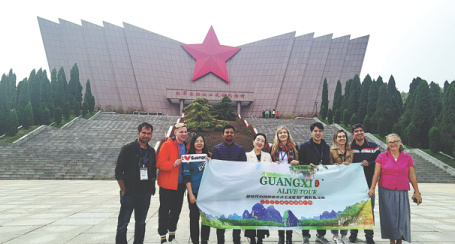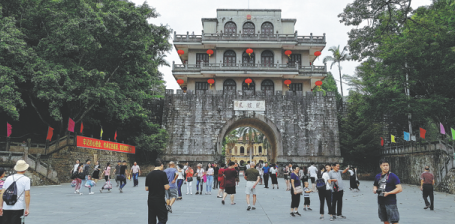Red tourism routes serving up stirring moments in Guangxi

The Lijiang River in Guilin, Guangxi Zhuang autonomous region, is a world natural heritage site. TENG BIN/FOR CHINA DAILY
Autonomous region has big plans lined up to grow patriotic education and develop industry
The Guangxi Zhuang autonomous region has revealed 10 Red tourism routes this year, in a bid to help people learn about the history of the Communist Party of China and promote local culture.
The move, which took place in early March, is part of Guangxi's efforts to celebrate the 100th anniversary of the founding of the CPC.
The 10 routes feature China's revolutionary histories including the stage of the armed independent regime of workers; the Battle of the Xiangjiang River; the armed revolution against Japan in southeast Guangxi; the Battle of Kunlun Pass; the revolutionary times of China and Vietnam; Sun Yat-sen's events in Guangxi; and the Jintian Uprising. It also covers routes elaborating Guangxi's achievements in construction and rural revitalization.
The routes span 14 cities in Guangxi. They cover different themes and have distinct characteristics, which can provide visitors with experiences to remember, appreciate the traditions from revolutionary times and boost Guangxi's tourism, local officials said.
From Taiping Rebellion against the Qing Dynasty (1644-1911) in the 1850s and 1860s and the period of the new-democratic revolution to the establishment of early Guangxi Party organizations and leading people's revolutionary movement, to various historical stages such as the War of Resistance Against Japanese Aggression (1931-45), the construction of the People's Republic of China, reform and opening-up, and the new era of socialism with Chinese characteristics, they demonstrate the achievements and revolutionary events led by the CPC and revolutionary cultural relics.

A tour consisting of visitors from abroad pauses for a photo in front of the memorial hall of the Battle of the Xiangjiang River. CHINA DAILY
In mid-March, the local authority organized the first tour with 50 individuals including journalists, travel experts and representatives from research institutions, to visit Longzhou county and Pingxiang city, one of the 10 routes.
"During the activity, I have learned a lot and have gained inspiration," said a participant in the tour surnamed Wang.
"Revolutionary tourism is an important source for conducting moral and traditional education. It plays a role in politics and I hope Guangxi can have a burgeoning development in revolutionary tourism to pass on the traditional spirit," Wang said.
The routes not only provide social communities in Guangxi with options to conduct patriotic education but promote local tourism businesses to develop the markets of Red tourism and offer more products and services, local officials said.
With the aim to protect and promote cultural heritage, the local government has designed the routes for one to three days traveling based on Guangxi's revolutionary resources. It has selected relevant resorts with convenient transport, which are eligible to receive tourists.
Located in the south of China, Guangxi is an important gateway to China to open up to the outside world and connect with the Association of Southeast Asian Nations.
Boasting cultural and tourism treasures, Guangxi is regarded as a destination with abundant revolutionary resources. The region has made constant efforts in protecting and developing its historical culture. It has realized achievements in revolutionary cultural inheritance, and seen growth in the tourist economy.
During the 13th Five-Year Plan (2016-20), Guangxi made a breakthrough in the revolutionary cultural tourism industry.
Over the five years, the region added 13 national 4A-level revolutionary tourist resorts, according to the region's cultural and tourism bureau.
In recent years, Guangxi has developed its revolutionary stations, which are another highlight in the region's tourism development.
Utilizing the grassroots Party organizations, the city of Guilin has built a group of revolutionary stations. So far, a total of 60 stations have been opened.

Visitors gather at the Friendship Pass in Pingxiang, Guangxi Zhuang autonomous region, which is situated on the China-Vietnam border. CHINA DAILY
"In recent years, Guangxi has increased its capital support for revolutionary tourism resorts. The central government and the local authority invest 31.24 million yuan ($4.9 million) annually to support the resorts' upgrading and the development of tourism," an official of the region's cultural and tourism bureau said.
Official data showed that a total of 84 counties were included as revolutionary areas.
Over the next five years, Guangxi will develop a revolutionary culture brand through efforts to build management teams to promote the integrated development of culture and tourism, local officials said.
By the end of the 14th Five-Year Plan (2021-25) period, the region will have trained more than 350 volunteers as tour guides. Guangxi is expected to build a group of revolutionary tourism resorts; one at national 5A-level, more than six at national 4A-level and more than eight new revolutionary tourism routes, according to its plan.
Next, the region said it will focus on promoting the integrated development of revolutionary tourism, which is planned to combine sectors including ecology, history and customs.
It will also deepen regional cooperation. This includes speeding up efforts to construct a multinational revolutionary tourism area between China and Vietnam; promote exchanges among its cities to develop a revolutionary tourism alliance; and launch more products and routes, local officials said.
